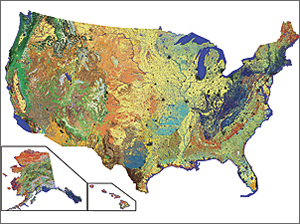LANDFIRE—Vegetation, Fuel, Fire, and More
By Don Long, Fire Ecologist, United States Forest Service
Highlights
- All spatial aspects of LANDFIRE are managed and processed within the ArcGIS environment.
- ArcGIS toolbars were developed to facilitate data download and processing.
- Decision tree models were used to map vegetation, fuel, and fire layers using ArcGIS.
LANDFIRE, the Landscape Fire and Resource Management Planning Tools Program, is a multiagency national mapping program that evolved from increased concern about wildfire severity and size. In 2001, the General Accounting Office (GAO) reported, "Federal land management agencies do not have adequate data for making informed decisions and measuring the agencies' progress in reducing fuels. These processes require accurate, complete, and comparable data."
In addition to the GAO reports, federal agency policy related to fire/fuel planning, forest restoration, and land health underscored the need for science-based planning. Federal scientists proposed LANDFIRE, a project with the objective of producing nationally consistent and locally relevant maps and data describing vegetation, wildland fuel, and fire regimes across the United States.
In 2002, the GAO reported, "On the basis of our review, LANDFIRE is the only proposed research project so far that appears capable of producing consistent national inventory data for improving the prioritization of fuel projects and communities." LANDFIRE was funded, and the first suite of LANDFIRE data products, LF_1.0.0, was completed in 2009. LF_1.0.0 has 23 layers for the conterminous United States, 17 layers for Alaska, and 16 for Hawaii.
LANDFIRE created and currently updates 30-meter raster data describing vegetation, major disturbances, and fire/fuel characteristics for the United States. It is the first midlevel-resolution national mapping program providing geospatial products to support natural resource management and fire/fuel planning. The most recent version, LF_1.1.0, incorporates vegetation transitions for disturbances from 1999 to 2008. Disturbances include fire, vegetation management, weather events, and insect/disease. Disturbance causality in the LANDFIRE disturbance grids 1999–2008 is determined in part using the user-contributed Events geodatabase, which is available for download.
Esri products are the backbone of data processing and delivery for LANDFIRE data products. Georeferenced plot data (available to the public) describing vegetation and fuel attributes is the basis of all mapping and resides in the LANDFIRE Reference Database (LFRDB). All spatial aspects of the LFRDB are managed and processed within the ArcGIS environment. Plot-based decision tree models were used to map vegetation and fuel/fire layers, with pre- and postprocessing/analysis performed using GIS. Toolbars were developed—the Total Fuel Change and the LANDFIRE Data Access Tool (LFDAT), utilizing Visual Basic .NET and ArcGIS technology—to facilitate modifications to mapping rule sets for updates/improvements and the creation of the LANDFIRE fuel layers for management scenario building in the case of the former and to facilitate data download and processing of LANDFIRE data for the latter, which also includes the Geospatial Data Abstraction Library.
To meet spatial analysis needs, LANDFIRE products are delivered in GIS from the LANDFIRE Data Distribution Site (DDS) hosted at the US Geological Survey's Earth Resources Observation and Science Center. Mosaics provide seamless delivery in the DDS, where users can view, select, and download data.
LFDAT is an interface between the DDS and GIS that allows users to easily locate an area of interest, draw an extent within ArcGIS, and download data. Options to modify data formats and projections are also available in LFDAT.
Work on both the LFRDB and Events geodatabases is ongoing. Users can learn more about this effort and how to contribute data at www.landfire.gov. Future additions to these databases will help inform updates of the LANDFIRE data products. Updates will continue to incorporate feedback from users, as well as mapping transitions in vegetation caused by disturbances. Remaps will incorporate methods resulting from ongoing research and development in the areas of vegetation, fuel, and disturbance mapping.
About the Author
Don Long is the science lead for the LANDFIRE program, which he has been with since its inception. He is a fire ecologist working for the USDA Forest Service at the Fire Lab in Missoula, Montana.
For more information, contact Don Long, fire ecologist, USDA Forest Service (e-mail: dlong01@fs.fed.us), or visit www.landfire.gov to learn about the LANDFIRE program and data products and to begin downloading data.
